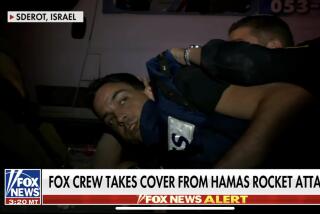TV’s Bright Lights Turn Off Pentagon Chiefs : Media: Broadcasters and military leaders trade angry words over spectacle as troops hit beach.
- Share via
WASHINGTON — The Pentagon and the television networks exchanged angry words Wednesday over which was to blame for the bizarre spectacle on the beaches of Somalia, where the first American forces landing before dawn were greeted by bright lights and hordes of broadcasters.
Although no casualties resulted, senior Pentagon officials, led by Defense Secretary Dick Cheney, complained that the TV lights could have put the troops in jeopardy, both by making them easy targets for possible snipers and by making their night-vision equipment useless.
“It was aggravating for our people to come in over the beach to find an army of photographers with their bright lights--television lights there to film the entire event,” Cheney said in a broadcast interview Wednesday.
That anger was echoed by relatives of the Marine and Navy Seal units involved in the landing and by hundreds of Americans who called in to radio and television talk shows Wednesday.
Insiders said that Cable News Network received about 300 telephone calls from viewers even before midnight Tuesday; about 80% of them were critical of the networks’ use of bright lights to cover the initial landing.
But the networks, including a top executive of CNN, charged that not only did the Pentagon fail to alert them to keep their lights off but that publicity-hungry military officials had invited them to be there, even telling them the time and place in advance.
Ed Turner, executive vice president of CNN, which provided continual coverage from the moment American troops hit the beach, said he was “astonished” at the Pentagon’s apparent eagerness to have the landing televised. “Twenty-four hours before the troops arrived, the State Department and the Pentagon were in effect, saying: ‘Everybody come on down, here’s the time, here’s the location--we’d love to have the attention, come visit us,’ ” Turner said.
Although the tension eased by the end of Wednesday, the incident seemed almost certain to reignite the controversy over what the press ought--and ought not--to cover during military operations. Bitter disputes on this issue flared during the Persian Gulf War two years ago, leading to new coverage ground rules but leaving some potential situations vague.
“The press didn’t win a big victory here,” said Donald S. Kellermann, director of the Times Mirror Center for The People & The Press, in Washington. “I think you’re going to see a buildup of aversion of what people are already calling irresponsible press action.”
Network officials said they hope this problem can be addressed without permanent new restrictions on press activities in future operations. “It’s more of a communications problem than an operational-type problem,” said Tom Goodman, director of media relations for CBS News.
Television crews used an assortment of equipment to record the landing of the advance units--troops whose faces had been blackened to make them less visible. Turner said that CNN employed only night-vision scopes that produced no dangerous illumination.
But other major networks used bright lights. CBS’ Goodman said the Pentagon did not ask camera crews not to use lights until after the Seals had landed--and that his crews immediately complied.
“The word came down after the fact. I think the whole thing was unfortunate,” he said. “Our intention was never to endanger anyone.” Spokespersons for NBC and ABC said much the same thing.
Military officials agreed that at least part of the problem appeared to be a communications breakdown.
Marine Lt. Gen. Martin Brandtner, director of operations for the Pentagon’s joint staff, said, in effect, that military planners thought the press had been given warnings to avoid the entire area and were surprised to find camera crews there when the troops landed.
“You have to understand that the presence notwithstanding of this kind of environment, we were still in a potentially hostile situation,” Brandtner said. “We just did not anticipate that the media would be on the beach proper itself.”
The Defense Department essentially acknowledged that lapse. Although Pentagon spokesman Pete Williams noted that he had generally suggested that journalists stay off the beach, he acknowledged that nothing was said about lights until after the Seals’ landing.
Eyes of the Night
Soldiers, sailors and air crews who must see and fight in the dark use complex night-vision equipment that makes the most of dim or infrared light. During the landing at Mogadishu, the glaring lights used for television cameras nearly blinded the personnel wearing this gear.
U.S. leads in night vision
The U.S. is said to have the best low-light and infrared sighting gear in the world, amplifying goggles. This equipment gives the troops a major edge in night battles.
Amplifying dim light
Low-light vision equipment captures reflected visible light too dim for the unaided human eye to see clearly, and electronically displays a brightened image somewhat like the viewfinder on a home video camera, with magnification.
Microchannel plate
Eyepiece
Objective lens
Phosphor screen
Photocathode
Source: U.S. Army Center for Night Vision & Electro-Optics
More to Read
Sign up for Essential California
The most important California stories and recommendations in your inbox every morning.
You may occasionally receive promotional content from the Los Angeles Times.












